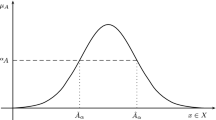Abstract
Assessing the parallelism between objects is an important issue when considering man-made objects such as buildings, roads, etc. In this paper, we address this problem in the fuzzy set framework and define novel approximate parallelism notions, for fuzzy segments and non-linear objects or groups of objects. The proposed definitions are in agreement with the intuitive perception of this spatial relation, as illustrated on real objects from satellite images.
Preview
Unable to display preview. Download preview PDF.
Similar content being viewed by others
References
Bloch, I.: Fuzzy spatial relationships for image processing and interpretation: a review. Image and Vision Computing 23(2), 89–110 (2005)
Bloch, I., Colliot, O., Cesar Jr., R.M.: On the ternary spatial relation between. IEEE Transactions on Systems, Man, and Cybernetics – Part B: Cybernetics 36(2), 312–327 (2006)
Bloch, I., Maître, H.: Fuzzy mathematical morphologies: A comparative study. Pattern Recognition 28(9), 1341–1387 (1995)
Ip, H.H.S., Wong, W.H.: Detecting perceptually parallel curves: Criteria and force driven optimization. Computer Vision and Image Understanding 68(2), 190–208 (1997)
Penedo, M.G., Ortega, M., Roucu, J., Penas, M., Alonso-Montes, C.: Certainty measure of pairwise line segment perceptual relations using fuzzy logic. In: Rueda, L., Mery, D., Kittler, J. (eds.) CIARP 2007. LNCS, vol. 4756, pp. 477–486. Springer, Heidelberg (2007)
Kang, H.-B., Walker, E.L.: Perceptual grouping based on fuzzy sets. In: IEEE International Conference on Fuzzy Systems, pp. 651–659 (1992)
Lowe, D.G.: Three-dimensional object recognition from single two-dimensional images. Artificial Intelligence 31(3), 355–395 (1987)
Sarkar, S., Boyer, K.L.: Perceptual organization in computer vision: a review and a proposal for a classificatory structure. IEEE Transactions on Systems, Man, and Cybernetics 23(2), 382–399 (1993)
Shen, D., Wong, W., Ip, H.H.S.: Affine-invariant image retrieval by correspondence matching of shapes. Image and Vision Computing 17(7), 489–499 (1999)
Author information
Authors and Affiliations
Editor information
Editors and Affiliations
Rights and permissions
Copyright information
© 2009 Springer-Verlag Berlin Heidelberg
About this paper
Cite this paper
Vanegas, M.C., Bloch, I., Maître, H., Inglada, J. (2009). Approximate Parallelism between Fuzzy Objects: Some Definitions. In: Di Gesù, V., Pal, S.K., Petrosino, A. (eds) Fuzzy Logic and Applications. WILF 2009. Lecture Notes in Computer Science(), vol 5571. Springer, Berlin, Heidelberg. https://doi.org/10.1007/978-3-642-02282-1_2
Download citation
DOI: https://doi.org/10.1007/978-3-642-02282-1_2
Publisher Name: Springer, Berlin, Heidelberg
Print ISBN: 978-3-642-02281-4
Online ISBN: 978-3-642-02282-1
eBook Packages: Computer ScienceComputer Science (R0)




